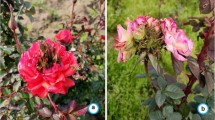Abstract
Withania somnifera is an important medicinal plant native to the Indian-sub continent. Owing to the presence of a number of precious alkaloids, flavonoids and withanolides, it is widely used in the Indian and African systems of medicines. It is severely affected by phytoplasma present in the sieve tubes of phloem. With a view to micropropagate phytoplasma-free W. somnifera plants, an efficient and effective nested PCR-based system was developed for detection of associated phytoplasmas. Universal primers, designed from the 16S rDNA sequences of phytoplasmas, were applied in direct/nested-PCR. Total DNA extracts from leaf tissues of 33 suspected symptomatic and 11 non-symptomatic plants were subjected to direct PCR. The direct PCR products were subsequently employed as templates in nested PCR. The nested PCR could reamplify direct PCR products yielding a DNA fragment of 1.4 kb. A phytoplasma was detected in all the diseased plants and not from the healthy looking plants. Further, it was sensitive enough to amplify phytoplasma DNA obtained from crude DNA diluted up to 2500 times from naturally infected plants and also from various stages of in vitro-propagated diseased plants. Identical restriction fragment polymorphism enzyme profiles were obtained following restriction enzyme digestion of nested PCR products, obtained from five different plants, by EcoRI, AluI and RsaI restriction endonucleases. The developed nested PCR based system should facilitate indexing of the phytoplasma in different stages of in vitro-generated plants and probably identification of, as yet unknown, hosts and vectors of phytoplasma associated with phytoplasma disease of W. somnifera.
Similar content being viewed by others
Abbreviations
- PCR:
-
polymerase chain reaction
- RFLP:
-
restriction fragment length polymorphism
References
Ahrens U, Seemüller E (1992) Detection of DNA of plant pathogenic mycoplasma like organisms by a polymerase chain reaction that amplifies a sequence of the 16S rRNA gene Phytopathology 82: 828–832
Altschul SF, Thomas LM, Alejandro AS, Zhang J, Zhang Z, Miller W, Lipman DJ (1997) Gapped BLAST and PSI-BLAST, a new generation of protein data base search programs. Nucleic Acids Research 25: 3389–3402
Anon. (1976). The Wealth of India (Raw Materials).Vol. X, 581–585, India: Council of Scientific and Industrial Research publication, New Delhi
Asthana R, Raina MK (1989) Pharcology of Withania somnifera (Linn.) Dunal-A Review. Indian Drugs 28: 199–205
Bertaccini A, Fránová J, Botti S, Tabanelli D (2005) Molecular characterization of phytoplasma in lilies with fasciation in the Czech Republic. FEMS Microbiology Letters 249: 79–85
Bhatti DS, Gupta DC, Dahiya RS, Malham I (1974) Additional hosts of the root-knot nematode, Meloidogyne javanica. Current Science 43: 622–623
Deng S, Hiruki D (1991) Amplification of 16S rRNA genes from culturable and nonculturable mollicutes. Journal of Microbiological Methods 14: 53–61
Duke JA (1985) Handbook of Medicinal Herbs. Boca Raton, Florida, USA: CRC Press
Favali MA, Musetti R, Benvenuti S, Bianchi A, Pressacco L (2004) Catharanthus roseus L. plants and explants infected with phytoplasmas: alkaloid production and structural observations. Phytoplasma 223: 45–51
Gundersen DE, Lee I-M (1996) Ultrasensitive detection of phytoplasma by nested-PCR assays using two universal primer pairs. Phytopathologia Mediterranea 35: 144–151
Lee L-M, Gundersen-Rindall DE, Davis RE, Bartoszyk IM (1998) Revised classification scheme of phytoplasma based on RFLP analyses of 16S rRNA and ribosomal protein gene sequences. International Journal of Systematic Bacteriology 48: 1153–1169
Lee L-M, Hammond RW, Davis RE, Gundersen DE (1993) Universal amplification and analysis of pathogen 16S rDNA for classification and identification of mycoplasmalike organisms. Phytopathology 83: 834–842
Mahrshi RP (1986) Withania somnifera – a new host for Myrothecium roridum. Indian Journal of Plant Pathology 16:199
Murashige T, Skoog F (1962) A revised medium for rapid growth and bioassays with tobacco tissue culture. Plant Physiology 15: 473–497
Parmessur Y, Aljanabi S, Saumtally S, Dookun-Saumtally A (2002) Sugarcane yellow leaf virus and sugarcane yellows phytoplasma: elimination by tissue culture. Plant Pathology 51: 561–566
Pathak HC, Raychoudhuri SP (1967) Withania somnifera – an additional host of tobacco leaf curl virus. Science Culture 33: 234–235
Perrière G, Gouy M (1996) WWW-Query: An on-line retrieval system for biological sequence banks. Biochimie 78: 364–369
Saitou N, Nei M (1987) The Neighbor-joining Method: a new method for reconstructing phylogenetic trees. Molecular Biology Evolution 4: 406–425
Schneider B, Seemüller E, Smart CD, Kirkpatrick BC (1995) Phylogenetic classification of plant pathogenic mycoplasma-like organisms or phytoplasmas. In: Razin S, Tully JG (eds) Molecular and Diagnostic Procedures in Mycoplasmology 1. Academic Press, San Diego, California, pp 369–380
Seemüller E, Marcone C, Lauer U, Ragozzino A, Göschl M (1998) Current status of molecular classification of the phytoplasmas. Journal of Plant Pathology 80: 3–26
Sen J, Sharma AK (1991) Micropropagation of W. somnifera from germinating seeds and shoot tips. Plant Cell, Tissue and Organ Culture 26: 71–73
Thompson JD, Higgins DG, Gibson TJ (1994) CLUSTAL W: improving the sensitivity of progressive multiple sequence alignment through sequence weighting, position specific gap penalties and weight matrix choice. Nucleic Acids Research 22:4673–4680
Zaim M, Samad A (1995) Association of phytoplasmas with a witches-broom disease of Withania somnifera (L.) Dunal in India. Plant Science 109: 225–229
Acknowledgements
The authors are thankful to Dr Rakesh Tuli (Director, NBRI) for helpful discussions, and Mr BR Singh for technical help with RFLP experiment. This work was supported by a research grant from the Department of Biotechnology (Government of India), New Delhi.
Author information
Authors and Affiliations
Corresponding author
Rights and permissions
About this article
Cite this article
Khan, J.A., Srivastava, P. & Singh, S.K. Sensitive Detection of a Phytoplasma Associated with Little Leaf Symptoms in Withania somnifera . Eur J Plant Pathol 115, 401–408 (2006). https://doi.org/10.1007/s10658-006-9029-0
Accepted:
Published:
Issue Date:
DOI: https://doi.org/10.1007/s10658-006-9029-0




